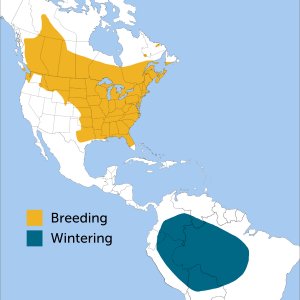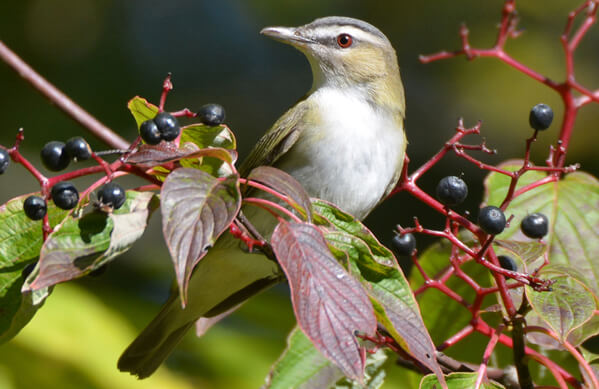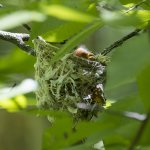
The Red-eyed Vireo is one of the most common songbirds of eastern and central U.S. forests during the summer months. Like the Ovenbird and Scarlet Tanager, it is more often heard than seen. A glimpse reveals an olive-green bird with contrasting slate-gray cap, black eye-stripes framing a white eyebrow, and vivid red eyes. But its rather subdued appearance is not this vireo's most well-known characteristic.
"The Red-eyed Vireo is preeminently famous as a singer," observed noted ornithologist Arthur C. Bent. "No other of our birds sings so persistently all day long, and because his long-continued series of utterances, given in short, emphatic phrases, going on for hours, calls to mind a lengthy sermon, he has won the title 'Preacher.'" One intrepid researcher counted the number of songs sung by a male Red-eyed Vireo on territory — the bird sang over 20,000 times in just 14 hours!
But the Red-eyed Vireo's seemingly endless song is notable for more than sheer staying power.
Vociferous Vireo Vocalist
In addition to its vocal endurance, a male Red-eyed Vireo commands a large repertoire of song phrases. Unlike other passerines, which sing the same song repeatedly, this talented vireo's "vocabulary" — which averages 47 different phrases — allows one male to sing over 30 song types, and combine those into up to 80 different songs! In addition, each male combines these phrases and song types in his own way.
Researchers have recorded an astounding 12,500 different Red-eyed Vireo song types — an amazing attribute for a supposedly unassuming songbird.
Unlike its song, the Red-eyed Vireo's call is a whiny mew that sounds somewhat similar to a Gray Catbird. Both males and females call aggressively in response to potential predators or intruders entering their territory.
Listen here:
(Audio: Andrew Spencer, XC105800. Accessible at https://www.xeno-canto.org/105800 · Molly Jacobson, XC562418. Accessible at https://www.xeno-canto.org/562418) · Andrew Spencer, XC30934. Accessible at https://www.xeno-canto.org/30945)
Taking the Red-eyed Flight
The Red-eyed Vireo is one of the most common migratory songbirds nesting in North America, with a breeding range spanning across the boreal forests of southern Canada and throughout deciduous forests of the northwestern, central, and eastern United States.
These small songbirds are mighty migrants, flying long distances at night in groups of up to 30, or in mixed-species flocks with migrating warblers, tanagers, and flycatchers. The Red-eyed Vireo flies all the way to northern South America for the winter, concentrating especially in the Amazon Basin. Wintering Red-eyed Vireos may remain with mixed-species flocks on their wintering grounds.
Swapping Menus
Like the Cape May Warbler, Wood Thrush, and many other Neotropical migrants, the Red-eyed Vireo is primarily insectivorous during the breeding season, taking a wide variety of insects, including caterpillars, beetles, cicadas, wasps, and grasshoppers. It moves slowly through the canopy while foraging, picking prey off leaves or stems with its stout, slightly hooked bill. It also flies out to snag insects in mid-air, sometimes continuing to sing as it secures its meal.
Interestingly, breeding Red-eyed Vireo pairs forage at different heights within the canopy, with males feeding higher in the trees, nearer to their singing perches, and females foraging at lower levels, closer to their nests.
As fall migration approaches, the Red-eyed Vireo adds a variety of berries and seeds to its diet, packing on the fat it needs to fuel its long-distance journey. During the winter, it switches to a largely fruit diet.
Aggressive Nest Defenders
Male Red-eyed Vireos return to the breeding grounds before females. Each male stakes out and defends a territory through song, patrolling a number of singing perches around the edge of his territory, and aggressively attacking and driving out intruding males throughout the breeding season.

Newly arriving females each choose a nest site within a male's territory. After mating, the female builds a cup-shaped, hanging nest between the fork of two tree branches, often concealed under hanging vegetation that provides extra security. Although not as pendulous as a Baltimore Oriole's, the vireo's pouch-like nest of grasses, roots, bark strips, and spider webs is easy to identify. Unfortunately, these beautiful nests are often found by the Brown-headed Cowbird, a brood parasite that lays its eggs in other bird's nests.
After completing her clutch, the female Red-eyed Vireo incubates her three to four eggs and broods the young after they hatch. The male will bring food to the female, starting during nest-building and continuing while she is taking care of the young. Red-eyed Vireos often nest several times per season, particularly if the first nest is unsuccessful.
Juvenile Red-eyed Vireos are easily identified by their brown eye color. They do not attain the red eyes of an adult until their second year.
A Need for Tall Trees and Clear Pathways
Although the Red-eyed Vireo remains abundant, it contends with the same threats facing rarer birds, particularly habitat loss and fragmentation on its breeding and wintering ranges. It is a frequent victim of collisions with glass, towers, and wind turbines.
ABC provides a number of resources to help reduce these threats. We are involved in a number of large-scale conservation initiatives to protect and recover habitat on breeding and wintering grounds, including BirdScapes, Joint Ventures, and Southern Wings. Our collisions program helps to prevent communications tower collisions and fatalities, and provides solutions to prevent bird collisions with glass, particularly at home windows.
Donate to support ABC's conservation mission!






















































